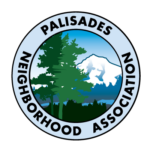This content has been archived. It may no longer be relevant
July 8, 2022
Synopsis of Survey Results
The Desired Neighborhood Character Survey the “survey” was made available through various media to all Palisades Neighborhood residents and was conducted from May 16, 2022 through June 8, 2022. 274 PNA residents replied – a strong return rate.
General Observations from the responses:
- A near uniform support for the preservation and enhancement of several characteristics of the Palisades Neighborhood, detailed below. (question 1 of 7, part a, 88% of respondents highly or moderately support preserving existing neighborhood character)
- A high percentage (>98%) of respondents own their home vs rent
- Fairly diverse distribution of length of time living in Palisades
- Fairly diverse distribution of home’s age, with most (>74%) of homes built before 1980
- 2/3 of respondents plan to age in place or live in their homes for 10 or more years
- The survey was a successful tool to:
- Elicit opinions regarding valued neighborhood characteristics
- Demonstrate strong support for creating the Overlay District to protect these characteristics
- Heighten residents’ awareness of the Palisades Neighborhood Association
- Increase the number of newsletter subscribers
Neighborhood Characteristics:
1 of 7 Characteristics with high importance include:
- Private, secluded, quiet backyards (highly or moderately valued by 96% of respondents)
- Encouraging retaining mature, healthy, native trees (92%)
- Front yards mostly landscaped (not paved) (89%)
- Preserve existing neighborhood character (88%)
- Architectural variety, as opposed to same style developer homes repeated several times on the same street, or nearby streets. (86%)
- New/remodeled homes in scale similar to existing (80%)
- Smaller, mid-century, ranch, split level, & traditional 2-story (65%)
2 of 7 Suggested Improvements (respondents could write in suggestions):
- Several respondents reiterated the desire to protect mature trees, limit the number of flags in flag lots, and have fewer “big box” homes
- Some comments were outside the scope of an overlay (traffic, need for sidewalks, streetlights, walking paths, elimination of gas-powered yard equipment, etc.) These comments will be forwarded to the appropriate city staff.
- Other comments regarded the desire to discourage or prohibit duplexes, triplexes, quadplexes, townhomes and cottage clusters (“Middle Housing”). State law now allows these building types on lots currently zoned for single family dwellings, and the city’s planning staff are currently in the process of revising the city’s development code to reflect this law. As such, the proposed overlay won’t be able to prohibit or discourage Middle Housing.
3 of 7 Regarding importance of natural systems/landscaping & buffering elements, the following were strongly supported:
- Management of surface water run-off (extremely, very, or moderately important to 95% of respondents)
- Preservation of healthy native trees (95%)
- Landscape screening to preserve privacy including retention of more healthy native trees (95%)
- Size, number, and species of replacement trees (92%)
4 of 7 Regarding elements of new/remodeled homes, the following were strongly supported:
- Some increase of building setbacks compared with the current zoning ordinance (93%)
- Some decrease in building height (93%)
- Some reduction of total square footage of home to property size (Floor Area Ratio, “FAR”) compared with the current zoning ordinance (90%)
- Amount of impervious surfaces (86%)
- Limitation on number of flags on a lot split to 2 compared with the current zoning ordinance (83%)
- Allow front facing garages to minimize impervious surfaces (82%)
5 of 7 Regarding impermeable surfaces (driveway and paving), the following were strongly supported:
- Concerns about surface drainage due to increased impermeable surfaces (92%)
- Amount of paving being visually consistent with neighborhood (90%)
- Local heat gain due to increased impervious surfaces (83%)
6 of 7 Regarding limiting number of flag lots on a lot split, 75% support a limit of 2 total lots regardless of lot size
7 of 7 Regarding front yard setbacks, 50% of respondents supported new setbacks greater than the code required 25’ (existing non-conforming setbacks are “grandfathered” in), while approximately 30% support the current code front setback. In total – 80% of respondents supported deeper front yard setbacks.
Submitted by Chris Durkee, PNA Land Use Committee Coordinator and Frederique Lavios, PNA Overlay Committee Coordinator
See also: PNA Neighborhood Character Survey Summary Visual Summary

